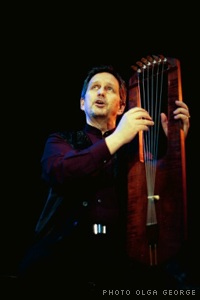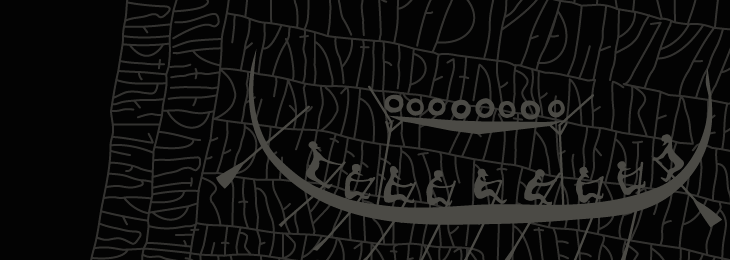A brief history of the Beowulf project
By Benjamin Bagby

I was first transfixed by Beowulf in a suburb of Chicago in the early 1960’s, when my English teacher, Mrs. Bennett, handed me Burton Raffel’s translation of the poem and laconically said ‘you need to read this’ (she later handed me yet another bombshell: Dante’s Inferno). Perhaps it’s not a coincidence that a few years later, in high school, I was utterly swept away by the sound of medieval music and started my first ensemble. The Anglo-Saxons would say that this was simply my wyrd (personal destiny).
In 1981, Sequentia (the medieval music ensemble I co-founded with Barbara Thornton) was invited to give a concert in Louvain, Belgium, as part of a university colloquium about performing historical vocal music. One of the participants in the colloquium was the Anglo-Saxonist Thomas Cable (University of Texas/Austin), who had recently published a book entitled The Meter and Melody of ‘Beowulf,’ discussing the theoretical backround for various possible modes of performance. We began to talk, and our discussions, along with my close collaboration with Vermont harp-builder Lynne Lewandowski, sowed the seeds for making the Beowulf story into a performance. The sound-image for this performance popped into my head a few months later, as I was driving through rural Arkansas one blustery March evening; perhaps my subconscious was prodded by the omnipresent local images of razorback hogs, kin to the wild boar, those symbols of fearlessness so dear to the Anglo-Saxons. An instrument was ordered and built, and the project slowly took musical shape, at first making use of shorter Old English poems (such as Caedmon’s Hymn and Deor) and later expanding into a short scene from Beowulf, which had its first public performance in 1987 and was integrated into a Sequentia concert program of medieval English music. Initial guidance with the intricacies of Anglo-Saxon pronunciation and meter was generously provided by Thomas Cable, during several memorable working sessions in his stone library-tower in Austin.
In 1990, I was approached by Jan Nuchelmans, then artistic director of the Utrecht Early Music Festival (Netherlands), about the idea of programming ‘an entire evening of Beowulf’ as part of the festival’s storytelling theme that summer. How could I possibly say no? With less than 5 months to put together a performance lasting about an hour (there were numerous deletions in the text necessary due to festival time constraints and, strangely, the last departure times of Utrecht buses & trams following late-night concerts), I worked feverishly to solve the many problems of shaping an ‘epic’ performance instead of a 10-minute ‘song’. This work was all accomplished with harp in hand and without the use of musical notation, and it was in this process of finding a new oral tradition to reconstruct a lost oral tradition that the project has its deepest roots. Following the premiere in the tiny crypt of the medieval Pieterskerk in Utrecht, this was the version of the story which I subsequently performed throughout Europe and North America during the mid-1990’s.
With the Lincoln Center Festival’s invitation to give a series of performances in New York, in 1997, the project received a huge boost in energy and interest. And it was during those subsequent difficult years 1997-2000 -- which witnessed the long illness and death of my partner Barbara Thornton and the uncertainty of Sequentia’s future -- that the Beowulf project took on a new importance and urgency: the memorization process was completed, deleted sections of text were restored, new instruments were acquired, and video titles were used for the first time. Sequentia’s long-time agent Jon Aaron became the producer of the Beowulf project and gained an expertise in Anglo-Saxon which allowed him to effortlessly run the video titles from his offstage laptop.
In the meantime, I have been performing Beowulf between Vancouver Island and the Faroe Islands; synagogues in Poland and the Lower East Side of New York; a warehouse in Los Angeles and a medieval art museum in Cologne; Perth, Pittsburgh and Perugia; the Cloisters and the Sydney Opera House; a high school in rural Texas and the Cité de la Musique in Paris. I have had much recent help with the text from John Miles Foley (University of Missouri/Columbia), the distinguished Anglo-Saxonist and scholar of oral poetry, who also oversaw the filming of the DVD in Helsingborn, Sweden, in 2006.
I am often asked if I plan to learn and perform the entire epic. In fact, during 2002 discussions were started about the possibility of preparing the complete Beowulf (3182 verses, or a performance time of roughly 5 hours) for a group of co-commissioners in the U.S., but sufficient interest and funding could not be found to make possible the development of such an intense, long-term project. The idea was reluctantly abandoned in 2004, but not before I had worked my way well into the scene with Grendel’s mother.
Responding to the Lincoln Center Festival’s invitation to return with Beowulf in 2006, I decided to expand my performance to include the final 20 minutes of the first episode (Beowulf’s defeat of Grendel and the subsequent celebrations), thereby making ‘Part I’ complete and containing the uncut text of lines 1-1062, the same version as was released on DVD. Only time will tell if I am able to continue working with the next episode.


